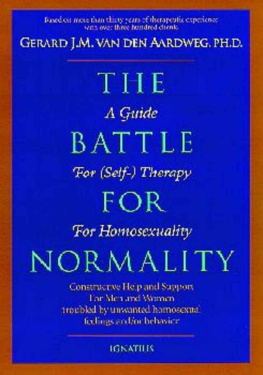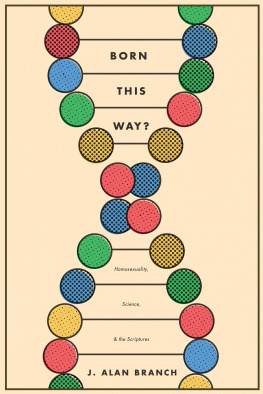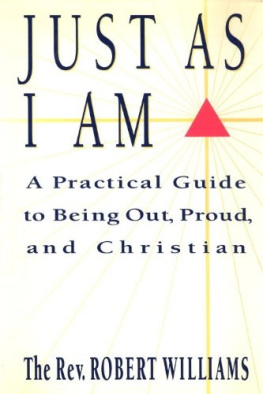THE BATTLE FOR NORMALITY
Gerard J. M. van den Aardweg, Ph.D.
THE BATTLE FOR
NORMALITY
A Guide for (Self-)Therapy for Homosexuality
IGNATIUS PRESS SAN FRANCISCO
Cover design by Roxanne Mei Lum
1997 Ignatius Press, San Francisco
All rights reserved
ISBN 978-0-89870-614-7
Library of Congress catalogue number 96-76830
Printed in the United States of America
To men and women tormented by homosexual emotions who do not want to live as homosexuals, who want constructive help and support, and who are forgotten, have no voice, and get no answers in our society, which recognizes only the emancipatory homosexual who wants to impose his ideology of normality and unchangeability and thus discriminates against those who know or feel that that is a sad lie .
CONTENTS
PART ONE: INSIGHTS
Insights in Brief
Not Normal
The Role of Self-Labeling
Homosexuality in the Genes? In the Brain ?
Irreversibly Programmed in the First Years of Life ?
Psychological Childhood Factors
The Masculinity/Femininity Inferiority Complex
Self-Dramatization and the Formation of an Inferiority Complex
The Search for Love and Affection
Homosexual Love
Homosexual Sex Addiction
Homosexual Relationships
Self-Destructive and Dysfunctional Tendencies
Remaining a Teenager: Infantilism
Neurotic from Discrimination ?
Nonneurotic Homosexuals ?
Normal in Other Cultures ?
Seduction
Homosexuality and Conscience
Religion and Homosexuality
PART TWO: PRACTICAL RULES FOR (SELF-)THERAPY
Sobering Remarks on Psychotherapy
The Need for a Therapist
Working through Childhood and Adolescence
Knowledge of the Present Self
Moral Self-Knowledge
Beginning the Battle: Hope, Self-Discipline, Sincerity
Fighting Neurotic Self-Pity; Humor
Patience and Humility
Fighting Homosexual Feelings
Fighting the Infantile Ego
Mending the Sex Role
Changing Ones Views of and Relationships with Others
Changing Relations with the Opposite Sex; Marriage
INTRODUCTION
This book gives guidelines for the therapy of homosexuality, which is essentially self-therapy. It is intended for homosexually inclined persons who want to do something about their condition themselves but do not have the opportunity to visit a therapist with healthy ideas on the matter. For, indeed, there are few of them. The chief reason for this is that the topic of homosexuality had been neglected or ignored at universities, and if mentioned at all, emphasis is placed on the normality ideology: homosexuality is just a natural sexual alternative. So there are far too few medical people, behavioral scientists, and psychotherapists who have even a rudimentary knowledge of this subject.
That the element of self-treatment predominates in any treatment of homosexuality does not as a rule mean that one can go it alone. He who wants to overcome emotional problems needs a realistically understanding and encouraging guide to whom he can speak his mind, to help him discover important aspects of his emotional life and of his motivations, and to coach him in his struggle with himself. That guide need not necessarily be a professional therapist. Preferredly, he should be, but on the condition that he has healthy ideas about sexuality and morality; if not, he may do more harm than good. Occasionally, a physician or pastor with a balanced and normal personality and a capacity for realistic human insights can fill this role. If there is no one better qualified available, it may even be advisable to ask a sensible and psychologically healthy friend or relative to function as guide, as far as possible. For therapists and others who may be in the position of having to support a homosexual who wants to change, this book therefore is secondarily aimed. They too cannot dispense with basic knowledge of the homosexual condition.
I present here what I think are the essentials with regard to insight and (self-)treatment of homosexuality, based on more than thirty years of study and therapeutic experience with more than three hundred clients whom I have come to know well for several years at least and with many other (clinical as well as nonclinical, that is, socially adapted) persons with this orientation. For research evidence relating to such factors as psychological testing and homosexuality, parental and other intrafamily relationships, and social adaptation in childhood, I refer to my two previous books in English, especially On the Origins and Treatment of Homosexuality (1986; see also Homosexuality and Hope , 1985).
A Good Will
Without a strong determination, a good will, no change is possible. With it, improvement is certain in the majority of cases, and in a minority, even a curea deep inner change in overall neurotic emotionality and a beneficial reversal of sexual interestsis achievable.
But who possesses that good will? Most afflicted persons, including those who militantly profess their gayness, somehow still have the desire to be normal, repressed as it may be. Only a minority, however, really wants to changeand wants it with some constancy, rather than as a mere impulse that is perhaps recurring, but quickly fades away. Even among those with the best resolution to fight their homosexuality, there is a good deal of second thought, a hidden cherishing of the alluring homosexual desires. So a good will is for the most part still a weak will; and, of course, the wills weakness is easily reinforced by all the social pressures to accept ones homosexuality. To persist in the resolution to change one must cultivate in oneself such motivators as a clear view of homosexuality as something unnatural; a sound moral and/or religious conviction; and, where applicable, the will to make the best of an existing marriage relationship that is reasonable, apart from the sexual aspect. Being well-motivated is not the same as practicing rigid self-bashing, self-hatred, or a fearful compliance with moral prescriptions simply because they are imposed by society or religion; rather, it is to have a quiet and strong feeling that homosexuality is incompatible with psychological maturity and/or moral purity, with the deepest stirrings of ones conscience, and with ones responsibility before God. To strengthen regularly ones moral resolution to fight the homosexual side of the personality is therefore crucial for a good outcome.
Results
Understandably, most of those considering treatment for their homosexuality, and other interested persons as well, are eager to know the percentage of cures. Simple statistics, however, do not convey all the information necessary for a balanced judgment. With regard to cures, according to my experience, about 10 to 15 percent of all who entered treatment (30 percent discontinued after some months) recovered radically. That is, after years of treatment they no longer have homosexual feelings and are normal in their hetero-sexuality; and their change only deepens in the course of the years. Andthe third and obligatory criterion for a radical changethey improve greatly in terms of overall emotionality and maturity. This last aspect is essential because homosexuality is not an isolated preference, but an expression of a specific neurotic personality. For instance, I have seen a few cases of amazingly rapid and complete change from homosexual to heterosexual interests in persons in whom an until-then dormant paranoia had got the upper hand. These are cases of real symptom substitution, which make us aware of the clinical fact that homosexuality is much more than a functional disturbance in the sexual realm.
The majority of those who try to practice regularly the methods to be discussed here do improve, as measured after several (three to five on average) years of treatment. Their homosexual desires and fantasies become weak to nonexistent; heterosexuality comes into existence or is considerably strengthened; and their personalities become less neurotic. Some, not all, however, suffer occasional relapses (under stress, for example) of their old homosexual imagery; but if they return to the struggle the relapse usually does not last for long.







